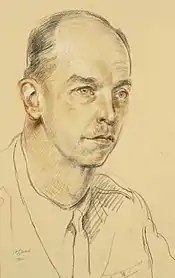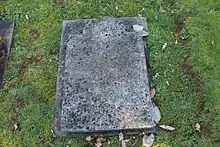Charles Loyd
General Sir Henry Charles Loyd, GCVO, KCB, DSO, MC, DL (12 February 1891 – 11 November 1973), nicknamed "Budget Loyd",[1] was a senior British Army officer who fought in both the world wars, most notably during the Second World War as General Officer Commanding (GOC) of the 2nd Infantry Division during the Battle of France in May 1940.
Sir Charles Loyd | |
|---|---|
 | |
| Nickname(s) | "Budget Loyd" |
| Born | 12 February 1891 Belgravia, Westminster, London, England |
| Died | 11 November 1973 (aged 82) Mettingham, Suffolk, England |
| Allegiance | United Kingdom |
| Service/ | British Army |
| Years of service | 1910–1947 |
| Rank | General |
| Service number | 17960 |
| Unit | Coldstream Guards |
| Commands held | London District Southern Command 2nd Infantry Division 1st Guards Brigade 3rd Battalion, Coldstream Guards 2nd Battalion, Coldstream Guards |
| Battles/wars | First World War Second World War |
| Awards | Knight Grand Cross of the Royal Victorian Order Knight Commander of the Order of the Bath Distinguished Service Order Military Cross Croix de guerre (France) Mentioned in despatches (3) |
Early life and First World War
Born on 12 February 1891 in Belgravia, Westminster, London, the son of Edward Henry Loyd, Charles Loyd was educated at Eton[2] and the Royal Military College, Sandhurst and was commissioned as a second lieutenant into the Coldstream Guards as a second lieutenant on 3 September 1910. Another future general, Arthur Smith, was among his fellow graduates.[3]
He served on the Western Front during the First World War with the 2nd Battalion, Coldstream Guards, then part of the 4th (Guards) Brigade of the 2nd Division, and was wounded in action four times, thrice mentioned in despatches, including on 1 January 1918,[4] awarded the Distinguished Service Order (DSO),[5] the Military Cross in 1915[6] and the French Croix de guerre.[7][8][9] He was also, by war's end, a brevet lieutenant colonel and, as Commanding Officer (CO) of the 2nd Battalion, Coldstream Guards, one of the youngest battalion commanders in the British Army.[9]
Between the wars
After the war Loyd was selected for the first postwar course at the Staff College, Camberley from 1919–1920.[9][8] In 1922 he married Lady Moya Brodrick, the youngest daughter of the St John Brodrick, 1st Earl of Midleton; they had two children, a daughter, Lavinia Gertrude Georgiana, born on 21 December 1923, and a son, Julian St. John, born on 25 May 1926.[10][8] In 1925 he returned to the Staff College, this time as an instructor, until 1926 when he was appointed CO of the 3rd Battalion, Coldstream Guards.[9]
He was promoted to regimental commander, commanding the Coldstream Guards regimental district, in 1932.[11] In 1934, he became a staff officer at the War Office, moving on to be a brigadier on the General Staff of British Troops in Egypt in 1936.[11] In 1938, he was appointed commander of the 1st (Guards) Brigade, then part of the 1st Infantry Division.[11][8] In June 1939 he was appointed General Officer Commanding (GOC) of the 2nd Infantry Division, three months before the outbreak of the Second World War.[12]
Second World War
His division, comprising the 4th, 5th and 6th Infantry Brigades and supporting units, was sent to France soon after war began, where it formed part of Lieutenant General Sir John Dill's I Corps of the British Expeditionary Force (BEF). The division fought in the Battle of France and the subsequent retreat to Dunkirk where it was withdrawn to England in the Dunkirk evacuation. However, on 16 May 1940, Loyd fainted during a conference and was evacuated to England, with command of the 2nd Division passing to Brigadier Noel Irwin, commander of the 6th Brigade.[9]
In 1941, after serving as Director of Infantry at the War Office in succession to Major General Henry Willcox, he became Chief of the General Staff (CGS) to General Sir Alan Brooke, the Commander-in-Chief, Home Forces, who had been a fellow student at the Staff College shortly after the First World War and thought highly of "Budget" Loyd, before moving on to be General Officer Commanding-in-Chief (GOC-in-C) of Southern Command in March 1942.[12][9] Knighted the following year, his last appointment was as Major-General commanding the Brigade of Guards and GOC London District in March 1944, a post which he held until he retired from the army, after the war, in 1947, after receiving a promotion to full general in 1946.[12][9]
Postwar

In retirement he was a Deputy Lieutenant of Norfolk.[13] He lived at Geldeston Hall in Norfolk.[13] He was a Justice of the Peace for the county in 1954, and from 1945 to 1966 he served as Colonel of the Coldstream Guards, after having his knighthood enhanced in 1965.[9]
References
- Field Marshal Lord Alanbrooke, War Diaries 1939–1945 (University of California Press, 2003), at page 137
- Smart, p. 195
- "No. 28412". The London Gazette. 2 September 1910. p. 6333.
- "No. 30450". The London Gazette (Supplement). 28 December 1917. p. 23.
- "Coldstream Guards officers awards, WW1". Northeastmedals.co.uk. 21 January 1921. Retrieved 22 April 2017.
- "No. 29351". The London Gazette (Supplement). 2 November 1915. p. 10891.
- "No. 30306". The London Gazette (Supplement). 25 September 1917. p. 9946.
- "British Army officer histories". Unit Histories. Retrieved 6 June 2017.
- Smart, p. 196
- Auction: Lot 41: Jacob More, 1740 – 1793 The Rape of Deianera; and Rest on the Flight to Egypt a pair, oil on canvas, laid down on board, oval
- Generals.dk
- Order of Battle
- "No. 40170". The London Gazette. 11 May 1954. p. 2776.
Bibliography
- Smart, Nick (2005). Biographical Dictionary of British Generals of the Second World War. Barnesley: Pen & Sword. ISBN 1844150496.
External links
| Military offices | ||
|---|---|---|
| Preceded by Henry Wilson |
GOC 2nd Infantry Division 1939–1940 |
Succeeded by Noel Irwin |
| Preceded by The Hon. Sir Harold Alexander |
GOC-in-C Southern Command 1942–1944 |
Succeeded by William Morgan |
| Preceded by Sir Arthur Smith |
GOC London District 1944–1947 |
Succeeded by Sir John Marriott |
| Honorary titles | ||
| Preceded by Sir Alfred Codrington |
Colonel of the Coldstream Guards 1945–1966 |
Succeeded by Sir George Burns |
